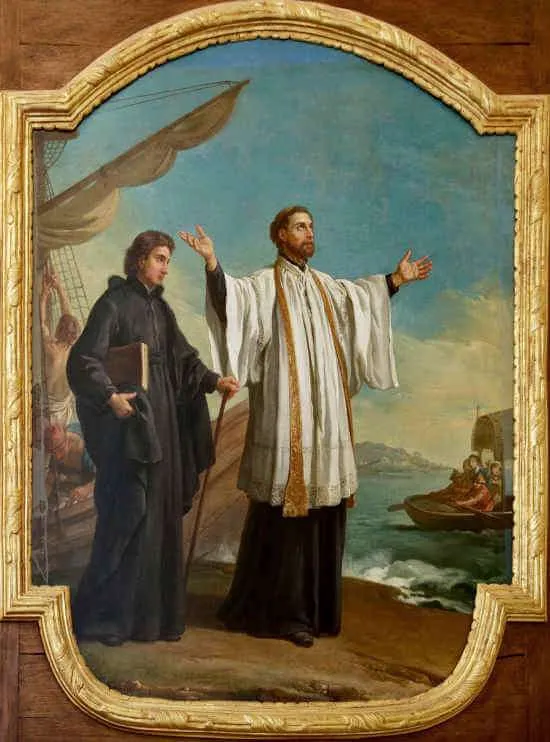After Emperor Constantine the Great legalized Christianity in the Roman Empire in 313, he began to construct churches, particularly in Rome, Jerusalem, and Constantinople. In Rome, he constructed four basilicas: Saint John Lateran, Saint Peter’s on Vatican Hill, Holy Cross of Jerusalem, and Saint Paul Outside the Walls. Today, the Church celebrates the dedication of two of those basilicas: Saint Peter’s on Vatican Hill and Saint Paul Outside the Walls.
The foundation of these two churches goes back to the first century when Peter and Paul shed their blood and were buried where the basilicas stand today. In 64, a great fire destroyed much of the city of Rome. Many historians believe Emperor Nero set the fires himself so he could have an excuse to rebuild portions of the city as he desired. Nero blamed the fire on the Christians and implemented the first organized persecution of Christians in the Roman Empire. Among the many who were arrested and martyred were Saints Peter and Paul.
Peter was the Prince of the Apostles and Bishop of Rome. He is believed to have been crucified upside-down in the Circus of Nero near the ancient Egyptian obelisk that now stands in the center of Saint Peter’s Square. He was buried in the nearby cemetery on Vatican Hill, and his grave became a place of pilgrimage for early Christians. After Constantine legalized Christianity, he became aware of the reverence with which this Prince of the Apostles’ grave was held, so he constructed what is now referred to as Old Saint Peter’s Basilica to help foster devotion and encourage pilgrimages to the site. The first basilica was dedicated by Pope Sylvester around the year 324 or 326 and remained for more than a millenia, with additions and reconstructions taking place during that time.
Until 1305, popes lived at the Basilica of Saint John Lateran, not at Saint Peter’s. When Pope Clement V was elected to the papacy, he moved the entire papal court to Avignon, France in 1309, where it remained until Pope Gregory XI returned to Rome from Avignon in 1377. At the time of the pope’s return to Rome, the Lateran Palace was in disrepair due to two fires, so the pope built a new papal palace next to Old Saint Peter’s on Vatican Hill, where every subsequent pope has resided. By the turn of the sixteenth century, Old Saint Peter’s was in serious disrepair, so in 1505, Pope Julius II ordered its demolition and began a process of reconstruction that spanned twenty-one subsequent papacies and was completed 120 years later. In 1626, the present-day Basilica of Saint Peter’s at the Vatican was dedicated by Pope Urban VIII.
Saint Paul was the tireless evangelist and the Church’s preeminent theologian, spreading the Gospel far and wide, and directly establishing and nourishing numerous Christian communities. He is also recognized as one of the earliest and most important converts to the faith. After an exceptional ministry of evangelization, Paul was arrested in Jerusalem. Because he was a Roman citizen, he appealed to the Roman emperor. He was subsequently imprisoned and two years later transported to Rome for his trial. When Nero’s persecutions were enacted shortly afterwards, Paul was beheaded on or around the same day that Saint Peter was crucified. Paul’s beheading is believed to have taken place just outside the walls of the city on the Ostian Way. He was buried near that spot.
Like the Old Saint Peter’s Basilica, the Basilica of Saint Paul Outside the Walls was built by Emperor Constantine over the grave of Saint Paul and dedicated by Pope Sylvester in 324. Over the next 1,500 years, successive popes added on to the basilica, renovated it, and decorated it. In 1823, almost the entire basilica was destroyed by a fire. Over the thirty years that followed, the church was redesigned and reconstructed into the church we have today. It was completed and dedicated in 1854 by Pope Pius IX.
As we honor the dedication of these two Roman basilicas, we honor much more than churches; we honor the apostles to whom they are dedicated. On June 29 each year, the Church celebrates the Solemnity of Saints Peter and Paul, honoring their unique and foundational ministries. Today, on November 18, we honor these two saints once again as we commemorate the dedication of the basilicas dedicated to them, which were built upon their graves.
Symbolically, as their graves stand as a foundation for these two churches, so their lives and ministry stand as a foundation for the entire Church. Saint Peter was the first pope and source of unity who was given the keys to the Kingdom of Heaven and of whom Jesus said, “And so I say to you, you are Peter, and upon this rock I will build my church, and the gates of the netherworld shall not prevail against it” (Matthew 16:18). Saint Paul was the great evangelist to the Gentiles and is a symbol of the Church missionary life and theological articulation of the faith, due to his extensive writings that make up most of the New Testament. Though we are centered and unified by Saint Peter the Rock, we must go forth to the ends of the earth, sharing the Gospel with all, like Saint Paul. Because of the significance of these apostles, every bishop throughout the world is obliged to make an “ad limina apostolorum” visit to Rome once every five years, during which time he gives a report to the pope about his diocese and visits the tombs of these two apostles.
As we honor these two great saints and revere their graves, ponder the fact that we are all called to become foundations on which the Church continues to be built. Our lives must become a source of unity for those who believe and a means by which God sends forth His Word to others. Renew today the dedication of your own life to the mission of Christ so that you more fully imitate the heroic and holy lives of these two men of God.
Source: https://mycatholic.life/saints/saints-of-the-liturgical-year/november-18—dedication-of-the-basilicas-of-saints-peter-and-paul-apostles/







